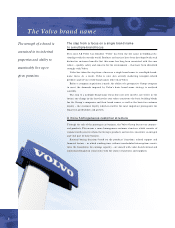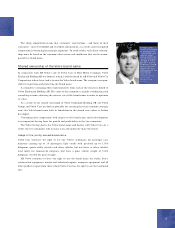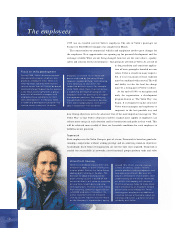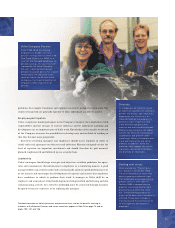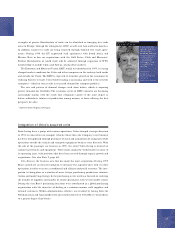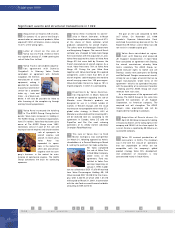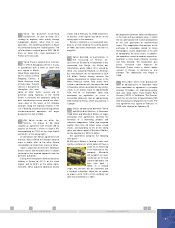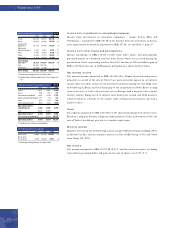Volvo 1999 Annual Report Download - page 20
Download and view the complete annual report
Please find page 20 of the 1999 Volvo annual report below. You can navigate through the pages in the report by either clicking on the pages listed below, or by using the keyword search tool below to find specific information within the annual report.
18
Fiscal year 1999
The world economy
improved substantially in
1999 after the risk of a
global recession, due
primarily to the crises in
Southeast Asia, had
diminished.
Business environm ent
Compared with expectations at the beginning of 1999, the world economy clearly
improved during the past year. The global growth in Gross Domestic Product, which
was revised upward during the year, amounted to some 3 percent. The improvement
followed the turbulence that occurred in connection with the crises, in Southeast Asia
in particular, in 1997–1998 and which threatened to cause a global recession. The
more favorable picture reflects primarily the unexpectedly strong economy in the
United States, a downturn in Japan that was milder than had been feared, an im-
provement in Korea, and somewhat better growth in the European Union.
The American economy continued to develop strongly based on domestic demand
in which increases in consumption were driven by declining unemployment and
sharply rising share prices. Countries in the Economic and Monetary Union (EMU)
survived the Asian crisis better than expected and activity there increased, due in part
to a weak euro and an expansive monetary policy. A recession in Japan was avoided
through comprehensive fiscal policy stimulus packages that could not, however, set in
motion ongoing growth. Economic activity increased earlier and more rapidly than
expected in the crisis-stricken countries in Southeast Asia, while the economies in
South America were generally stabilized following the crisis in Brazil at the beginning
of the year.
The euro weakened relative to the U.S. dollar in the international currency markets.
The Swedish krona also declined relative to the dollar but strengthened against the
euro during the year. Long-term interest rates fell during the first part of 1999, due to
declining global expectations of inflation and lower real interest rates. Interest rates
rose during the second half of the year when outlook for growth improved and
monetary policy was tightened in North America and Europe. The declining trend of
raw-material prices was interrupted during the first half of 1999 and prices rose during
the remainder of the year.
Against the background of a more favorable global business climate, demand was
high in many of Volvo’s most important markets. The total market for trucks reached
a record level in the U.S., and growth increased through to the first half of the year and
then slowed during the second half of the year. Despite a more cautious economic
activity in Western Europe, record levels were also posted. However, the market for
heavy construction equipment declined somewhat, mainly due to a downturn in the
U.S. General demand was weak in most of Volvo’s developing markets.
Changed conditions for trade
As regards the development of trade policy in 1999, special attention was focused on
the World Trade Organization (WTO) meeting in Seattle, where member countries
failed to reach agreement on a new round of global negotiations on trade liberalization.
However, this may be viewed more as a lack of agreement on what a new round should
contain than as an expression of growing protectionism. On the contrary, a number of
Board of Directors’ report
GDP growth in the OECD %
5
Q1 Q2 Q3 Q2 Q3 Q4 Q1 Q2
1997 1998 1999
Q3 Q4
4
3
2
1
0
Q4 Q1
1
Source: EcoWin
1 Preliminary


